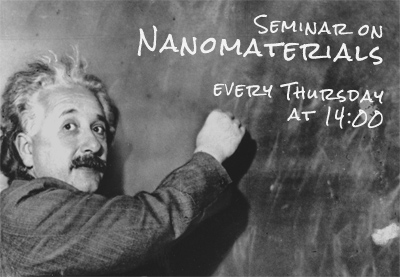Nanoseminar
Group of Structure analysis at the Department of Condensed Matter Physics
of Charles University and MGML has a pleasure to invite you to attend the seminar on nanomaterials: Physics, Technology, Applications
on 9th November 2023 at 14:00
at Faculty of Mathematics and Physics of Charles University, Ke Karlovu 5, 121 16 Praha 2
Lecture room F2
Jan Sýkora
University of Chemistry and Technology Prague
NMR-omics, from aerosols to metabolites
Jan Sýkora » NMR-omics, from aerosols to metabolites
NMR spectroscopy can be utilized in the analysis of complicated mixtures of organic substances, advantageously. If we intend to identify or even quantify the individual substances in a mixture, we have to know a spectrum of a pure substance. The identification of a given substance can be then realized on the basis of a single signal, which is easily recognizable in the spectrum of the whole mixture. Subsequently, it is necessary to find out whether all the remaining signals of a given substance are present in the spectrum. If so, the intensity of all its signals have to be adjusted proportionally to the intensities of the signals in the spectrum of the mixture. Comparing the signal intensity with the signal of a standard, we get the information on compound concentration in the sample. This procedure is called compound profiling and it works best when analyzing a pre-defined group of substances in a given matrix. Such samples can be, for example, bodily fluids, in which we look for individual metabolites, this is called metabolomics. Based on the concentrations of the most common organic substances such as simple organic acids, carbohydrates, alcohols, etc., we can determine the origin and quality of food via so-called foodomics. Aerosolomics, on the other hand, deals with concentrations of substances in air particulate matter and subsequently identifies the origin of air pollution. Compound profiling is a universal approach that can find wide application, but it is still a quite new topic, at least in the Czech Republic. Advanced methods of statistical analysis are an integral part of the processing of the obtained data. It enables to find subtle differences in the concentrations between pre-defined groups. We can thus distinguish between samples of healthy individuals and patients, or prediction models can be constructed to predict how an at-risk individual will develop in future. We are currently dealing with projects focused on, for example, early diagnosis of pancreatic cancer, Alzheimer's disease or hepatocellular carcinoma. We mainly work with blood samples, but we have also an experience with breath condensate or cerebrospinal fluid samples. Based on statistical analysis, we can determine metabolites with significant alterations in concentration and subsequently identify affected metabolic pathways. Using NMR metabolomics, the development of the disease can be monitored over time, or the individual's response to ongoing treatment can be studied. Targeted analysis can also monitor the metabolism of a given drug in the body. In short, there are many possible directions of research.
References:
[1] Michálková, L.; Horník, Š.; Sýkora, J.; Setnička V.; Bunganič, B. Prediction of Pathologic Change Development in the Pancreas Associated with Diabetes Mellitus Assessed by NMR Metabolomics. J. Proteome Res. 2023, 22(6), 1936–1946. https://doi.org/10.1021/acs.jproteome.3c00047


